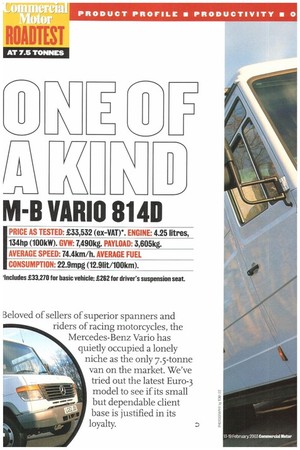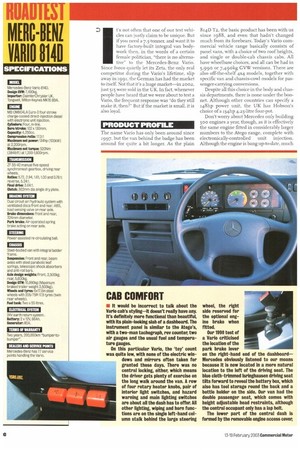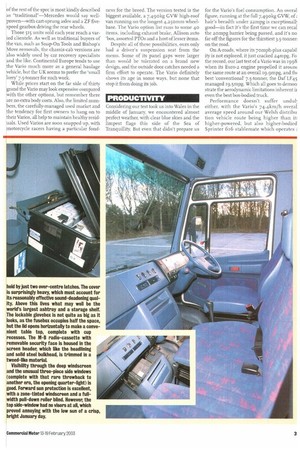M-B VARIO 8140
Page 28

Page 30

Page 31

Page 32

If you've noticed an error in this article please click here to report it so we can fix it.
IPRICE AS TESTED: 03,532 (ex-VAT)*. ENGINE: 4.25 litres, 134hp (100kW). GVW: 7,490kg. PAYLOAD: 3,605kg. AVERAGE SPEED: 74.4km/h. AVERAGE FUEL CONSUMPTION: 22.9mpg (12.91it/100km). 'Includes 133270 for basic vehicle; £262 for driver's suspension seat.
Beloved of sellers of superior spanners and riders of racing motorcycles, the Mercedes-Benz Vario has quietly occupied a lonely niche as the only 7.5-tonne van on the market. We've tried out the latest Euro-3 model to see if its small but dependable client base is justified in its loyalty.
1 Vs not often that one of our test vehi
cles can justly claim to be unique. But if you need a 7.5-tonner, and want it to have factory-built integral van body work then, in the words of a certain
female politician, "there is no alterna
tive" to the Mercedes-Benz Vario. Since Iveco quietly let its Zeta, the only real competitor during the Vane's lifetime, slip away in 1991, the German has had the market to itself. Not that it's a huge market—in 2002, ust 515 were sold in the UK, In fact, whenever people have heard that we were about to test a Vario, the frequent response was "do they still make it, then?" But if the market is small, it is also loyal.
PRODUCT PROFILE
The name Vario has only been around since 1997, but the van behind the badge has been around for quite a bit longer. As the plain
8r4D Tz, the basic product has been with us since 1988, and even that hadn't changed much from its forebears. Today's Vario commercial vehicle range basically consists of panel vans, with a choice of two roof heights, and single or double-cab chassis cabs. All have wheelbase choices, and all can be had in 5,990 or 7,49 okg GVW versions. There are also off-the-shelf 4x4 models, together with specific van and chassis-cowl models for passenger-carrying conversions.
Despite all this choice in the body and chassis departments, there is none under the bonnet. Although other countries can specify a 148hp power unit, the UK has Hobson's choice of a 134hp 4.25-litre four-pot.
Don't worry about Mercedes only building 500 engines a year, though, as it is effectively the same engine fitted in considerably larger numbers to the Atego range, complete with electronically-controlled unit injection. Although the engine is bang up-to-date, much of the rest of the spec is most kindly described as "traditional"—Mercedes would say wellproven—with cart-sprung axles and a ZF fivespeed gearbox driving the rear wheels.
Those 515 units sold each year reach a varied clientele. As well as traditional buyers of • the van, such as Snap-On Tools and Bishop's Move removals, the chassis-cab versions are also widely used by car recovery specialists and the like. Continental Europe tends to use the Vario much more as a general haulage vehicle, but the UK seems to prefer the 'small lorry' 7.5-tonner for such work.
While prices start on the far side of thirty grand the Vario may look expensive compared with the other options, but remember there are no extra body costs. Also, the limited numbers, the carefully-managed used market and e tendency for first owners to hang on to err Varios, all help to maintain healthy resid
als. Used Varios are soon snapped up, with motorcycle racers having a particular fond
ness for the breed, The version tested is the biggest available, a 7,490kg GVW high-roof van running on the longest 4,25 omm wheelbase. The Vario option list runs to some 40 items, including exhaust brake, Allison auto 'box, assorted PTOs and a host of lesser items.
Despite all of these possibilities, ours only had a driver's suspension seat from the menu. Some of its panel gaps were larger than would be tolerated on a brand new design, and the outside door catches needed a firm effort to operate. The Vario definitely shows its age in some ways, but none that stop it from doing its job.
PRODUCTIVITY
Considering our test took us into Wales in the middle of January, we encountered almost perfect weather, with clear blue skies and the limpest flags this side of the Sea of Tranquillity. But even that didn't prepare us
for the Vario's fuel consumption. An overal figure, running at the full 7,4 9okg GVW, of hair's breadth under 22mpg is exceptionall■ good—in fact it's the first time we can recal the 2ompg barrier being passed, and it's no far off the figures for the thirstiest 3.5-tormer: on the road.
On A-roads, where its 7 omph-plus capabil ity is not explored, it just cracked 24mpg. Po the record, our last test of a Vario was in 1998 when its Euro-2 engine propelled it aroum the same route at an overall 19.9mpg, and tilt best 'conventional' 7.5-tonner, the Daf LP4.5 managed 19.5mpg. Which all goes to demon strate the aerodynamic limitations inherent it even the best box-bodied truck.
Performance doesn't suffer undul: either, with the Vario's 74.4km/h overal average speed around our Welsh distribu tion vehicle route being higher than it: higher-powered, but also higher-bodied Sprinter 616 stablemate which operates Kinne-and-a-half lighter.
We need to be careful when discussing payoad relative to competitors with chassis-cab ind separate bodies, as the Vario obviously foesn't need to have extra weight added to its !x-factory kerbweight.
So the Vario's 3,885kg kerbweight is actuilly considerably better than an Atego 818 :hassis-cab's 3,882kg. Where the Vario possi)Iy loses out is in outright volume. Its 17.4m3 )f space is your lot, and compares mfavourably with the 28111i or so that would )e possible in a box body on a 'normal 7.5.onner.
Access into that still-cavernous boot is via ;uitably large doors. The single nearside slider s a pallet-friendly 1,095mm wide which, hanks to the intrusion from the twin-rear vheels, is actually wider than the 1,o4.2rnm ;pace between the wheelarches, The unglazed -ear doors open to a full 27o° with a simple ;tay at 9e.
A small offset step helps to negotiate the 34omm floor height, and no less than five Jairs of lashing rings are available to secure oads to the resin ply floor. There aren't many tans with room to stand upright in the cab, )ut the Vario is one, The extra headroom :ould perhaps be more usefully utilised as a Luton' storage area
The Vario is unique in more ways than one. Dne is that it is just about the only Mercedes )roduct not to be on the "Assysf variable naintenance interval programme, having ixed 45,o ookrn intervals instead. However, he company says that Vario will get with the )rogramme when it becomes Euro-4 compliint, The warranty is also different to other Vlercs, being two years or 200,000k_m luration.
ON THE ROAD
The Vario's performance is definitely a tale of two parts. Off the line from a standing start, its relatively modest power-to-weight ratio gives it a slight disadvantage against the 150 or even 18ohp produced by most modern 7,5tanners. Once rolling, though, the flat torque curve—with at least 500 of the maximum 520Nm of torque available between r,000 and 1,800rpm—ailows it to maintain its speed quite happily. The engine's installation makes it feel quite different to the identical unit in the Atego. Being so close to the driver, just beyond the removable access cover, the engine communicates with the driver more and sometimes feels to be working harder than it actually is.
It's much better suited to 5 omph A-road running, where it's pulling 1,650rpm, right at the very top end of maximum torque, rather than at the motorway limit. That said, nothing on the M4 between Newbury and Newport cost it more than 5mph. On the pull out of Monmouth towards Symonds Yat, it romped up in top without breaking a sweat in a quite respectable 2 minutes, 23 seconds.
The only minor criticism of the Vario's performance is the particularly noticeable gap between third and fourth gears. Although our Continental friends are able to overcome this by specifying a Z F six-speed gearbox, the option is not available on right-hand-drive Varios.
The ride was firm but well-controlled, surprisingly so given the unsophisticated specification of the suspension, with steel leaf-suspended beam axles at each end. Handling, even through the twisty A-road sections, was impeccable. In more urban operations, its narrow dimensions and excellent manoeuvrability, with a turning circle to shame some much smaller vehicles, makes it surprisingly easy to drive. The all-disc air-over-hydraulic brakes felt a little unresponsive on the first application from cold, but improved noticeably thereafter.
SUMMARY
At first look, the Vario might seem to be a dinosaur, a relic of another age. Its low-tech paper specification, its plain-Jane appearance and its modestly appointed interior do nothing to dispel the image. But load it up and put it to work and it gives a thoroughly modern performance. The Vane owners' club may be a small group, but its loyalty is understandable, and as M-B's thoughts over how it will be affected when Euro-4 engines arrive prove, is likely to be repaid for some time to come.
Apart from the rather too widely-spaced gears, the Vario's performance is excellent, while the fuel economy is nothing short of astonishing. If the Vario is the only product that does what you want it to do, it's really rather lucky that it does it so well.
• by Colin Barnett




































































































































































